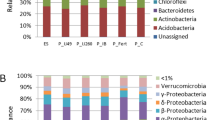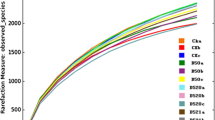Abstract
Due to the increasing demand for phytoremediation, many transgenic poplars have been developed to enhance the bioremediation of heavy metals. However, structural changes to indigenous fungal communities by genetically modified organisms (GMO) presents a major ecological issue, due to the important role of fungi for plant growth in natural environments. To evaluate the effect of GM plant use on environmental fungal soil communities, extensive sequencing-based community analysis was conducted, while controlling the influence of plant clonality, plant age, soil condition, and harvesting season. The rhizosphere soils of GM and wild type (WT) poplars at a range of growth stages were sampled together with unplanted, contaminated soil, and the fungal community structures were investigated by pyrosequencing the D1/D2 region of the 28S rRNA gene. The results show that the overall structure of the rhizosphere fungal community was not significantly influenced by GM poplars. However, the presence of GM specific taxa, and faster rate of community change during poplar growth, appeared to be characteristic of the GM plant-induced effects on soil-born fungal communities. The results of this study provide additional information about the potential effects of GM poplar trees aged 1.5–3 years, on the soil fungal community.
Similar content being viewed by others
References
Ashida, J. 1965. Adaptation of fungi to metal toxicants. Annu. Rev. Phytopathol.3, 153–174.
Becker, R., Behrendt, U., Hommel, B., Kropf, S., and Ulrich, A. 2008. Effects of transgenic fructan-producing potatoes on the community structure of rhizosphere and phyllosphere bacteria. FEMS Microbiol. Ecol.66, 411–425.
Cherian, S. and Oliveira, M.M. 2005. Transgenic plants in phytoremediation: recent advances and new possibilities. Environ. Sci. Technol.39, 9377–9390.
Choi, Y.I., Noh, E.W., Lee, H.S., Han, M.S., Lee, J.S., and Choi, K.S. 2007. Mercury-tolerant transgenic poplars expressing two bacterial mercury-metabolizing genes. J. Plant Biol.50, 658–662.
Colwell, R.K. and Coddington, J.A. 1994. Estimating terrestrial biodiversity through extrapolation. Philos. T. Roy. Soc. B.345, 101–118.
Conrad, R. 1996. Soil microorganisms as controllers of atmospheric trace gases (H2, CO, CH4, OCS, N2O, and NO). Microbiol. Rev.60, 609–640.
Gadd, G.M. 1993. Interaction of fungi with toxic metals. New Phytol.124, 25–60.
Gehring, C.A., Mueller, R.C., and Whitham, T.G. 2006. Environmental and genetic effects on the formation of ectomycorrhizal and arbuscular mycorrhizal associations in cottonwoods. Oecologia149, 158–164.
Gottel, N.R., Castro, H.F., Kerley, M., Yang, Z.M., Pelletier, D.A., Podar, M., Karpinets, T., Uberbacher, E., Tuskan, G.A., Vilgalys, R., andet al. 2011. Distinct microbial communities within the endosphere and rhizosphere of Populus deltoides roots across contrasting soil types. Appl. Environ. Microbiol.77, 5934–5944.
Gross, S. and Robbins, E.I. 2000. Acidophilic and acid-tolerant fungi and yeasts. Hydrobiologia433, 91–109.
Hamady, M., Lozupone, C., and Knight, R. 2010. Fast UniFrac: facilitating high-throughput phylogenetic analyses of microbial communities including analysis of pyrosequencing and Phylo-Chip data. ISME J.4, 17–27.
Hur, M., Kim, Y., Song, H.R., Kim, J.M., Choi, Y.I., and Yi, H. 2011. Effect of genetically modified poplars on soil microbial communities during the phytoremediation of waste mine tailings. Appl. Environ. Microbiol.77, 7611–7619.
Huson, D.H., Auch, A.F., Qi, J., and Schuster, S.C. 2007. MEGAN analysis of metagenomic data. Genome Res.17, 377–386.
Jeon, Y.S., Chung, H., Park, S., Hur, I., Lee, J.H., and Chun, J. 2005. jPHYDIT: a JAVA-based integrated environment for molecular phylogeny of ribosomal RNA sequences. Bioinformatics21, 3171–3173.
Karlinski, L., Rudawska, M., Kieliszewska-Rokicka, B., and Leski, T. 2010. Relationship between genotype and soil environment during colonization of poplar roots by mycorrhizal and endophytic fungi. Mycorrhiza20, 315–324.
Kumar, S., Nei, M., Dudley, J., and Tamura, K. 2008. MEGA: a biologist-centric software for evolutionary analysis of DNA and protein sequences. Brief. Bioinform.9, 299–306.
Li, W. and Godzik, A. 2006. Cd-hit: a fast program for clustering and comparing large sets of protein or nucleotide sequences. Bioinformatics22, 1658–1659.
Lodge, D.J. 1989. The influence of soil-moisture and flooding on formation of Va-endomycorrhizae and ectomycorrhizae in populus and salix. Plant Soil117, 243–253.
Lottmann, J., O’Callaghan, M., Baird, D., and Walter, C. 2010. Bacterial and fungal communities in the rhizosphere of field-grown genetically modified pine trees (Pinus radiata D.). Environ. Biosafety Res.9, 25–40.
Oliver, K.L., Hamelin, R.C., and Hintz, W.E. 2008. Effects of transgenic hybrid aspen overexpressing polyphenol oxidase on rhizosphere diversity. Appl. Environ. Microbiol.74, 5340–5348.
Raven, P.H., Evert, R.F., and Eichhorn, S.E. 1992. Biology of Plants. Worth Publishers, New York, N.Y., USA.
Rugh, C.L., Senecoff, J.F., Meagher, R.B., and Merkle, S.A. 1998. Development of transgenic yellow poplar for mercury phytoremediation. Nat. Biotechnol.16, 925–928.
Saitou, N. and Nei, M. 1987. The neighbor-joining method: a new method for reconstructing phylogenetic trees. Mol. Biol. Evol.4, 406–425.
Stefani, F.O., Moncalvo, J.M., Seguin, A., Berube, J.A., and Hamelin, R.C. 2009. Impact of an 8-year-old transgenic poplar plantation on the ectomycorrhizal fungal community. Appl. Environ. Microbiol.75, 7527–7536.
Thompson, J.D., Gibson, T.J., and Higgins, D.G. 2002. Multiple sequence alignment using ClustalW and ClustalX. In Curr Protoc Bioinformatics, pp. 2.3.1–2.3.22.
Van der Auwera, G., Chapelle, S., and De Wachter, R. 1994. Structure of the large ribosomal subunit RNA of Phytophthora megasperma, and phylogeny of the oomycetes. FEBS Lett.338, 133–136.
Weinert, N., Meincke, R., Gottwald, C., Heuer, H., Gomes, N.C., Schloter, M., Berg, G., and Smalla, K. 2009. Rhizosphere communities of genetically modified zeaxanthin-accumulating potato plants and their parent cultivar differ less than those of different potato cultivars. Appl. Environ. Microbiol.75, 3859–3865.
Wolfenbarger, L.L. and Phifer, P.R. 2000. The ecological risks and benefits of genetically engineered plants. Science290, 2088–2093.
Author information
Authors and Affiliations
Corresponding author
Additional information
Supplemental material for this article may be found at http://www.springer.com/content/120956.
The sequence data from this study are available from GenBank under the accession number SRA048656.1.
Electronic supplementary material
Rights and permissions
About this article
Cite this article
Hur, M., Lim, Y.W., Yu, J.J. et al. Fungal community associated with genetically modified poplar during metal phytoremediation. J Microbiol. 50, 910–915 (2012). https://doi.org/10.1007/s12275-012-2491-9
Received:
Accepted:
Published:
Issue Date:
DOI: https://doi.org/10.1007/s12275-012-2491-9




